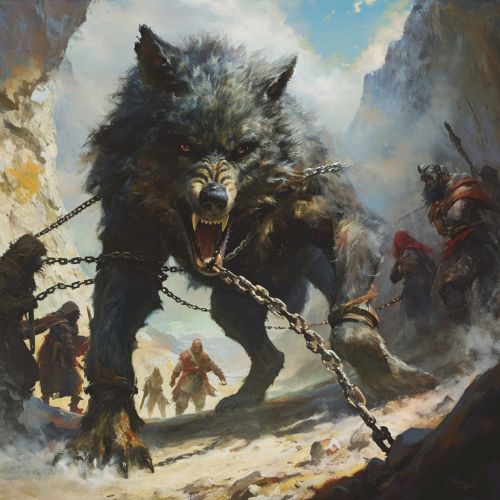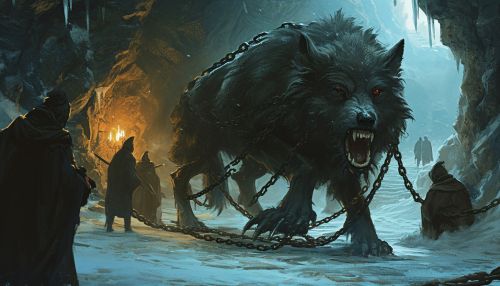Fenrir
Origins
In Norse mythology, Fenrir is a monstrous wolf, a son of the trickster god Loki and the giantess Angrboda. The prophecy foretelling the wolf's role in the destruction of the world, known as Ragnarok, led the gods to bind Fenrir, resulting in a cycle of betrayal and violence.
Etymology
The name Fenrir is derived from Old Norse 'fen-dweller'. The Old Norse form of the name is 'Fenrisúlfr'. It is often translated as 'Fenris wolf', combining the name of the mythological wolf with a common animal name to create a compound. The name Fenrir is related to the Norse word 'fen', meaning marsh or swamp, and 'úlfr', meaning wolf.
Mythological Accounts
Fenrir is mentioned in three stanzas of the poem Völuspá and in two books of the Prose Edda written by the Icelandic scholar and historian Snorri Sturluson in the 13th century.
Birth and Binding


Fenrir was born to Loki and Angrboda along with his siblings, the serpent Jormungandr and the half-dead, half-living Hel. The gods, fearing the destruction they would cause, brought the three siblings to Asgard, the realm of the gods. Fenrir grew rapidly, and his size and strength caused the gods to fear him. They decided to bind him, but the wolf broke every chain they put on him. Finally, the gods commissioned the dwarves to create a magical ribbon, Gleipnir, which was as thin as a silken strand but stronger than any chain. The gods challenged Fenrir to break Gleipnir, and the wolf, suspecting trickery, agreed only if one of the gods would place their hand in his mouth as a pledge of good faith. The god Tyr agreed, and when Fenrir found himself unable to break Gleipnir, he bit off Tyr's hand.
Ragnarok
Fenrir plays a crucial role in Ragnarok, the end of the world in Norse mythology. It is prophesied that during Ragnarok, Fenrir will break free from his bonds and run through the world with his lower jaw against the ground and his upper jaw in the sky, devouring everything in his path. He will kill the god Odin, but will, in turn, be killed by Odin's son, Vidar.
Symbolism and Interpretation
Fenrir is often seen as a symbol of destructive forces, uncontrollable rage, and raw, primal power. His binding can be interpreted as an attempt by the gods to maintain order and stave off chaos, while his eventual breaking free and devouring Odin symbolizes the inevitable triumph of chaos over order, and the cyclical nature of the Norse cosmos.
In Popular Culture
Fenrir has been depicted in various forms of modern media, including literature, film, and video games. He is often portrayed as a massive, fearsome wolf, and his role in Ragnarok is a common theme.
